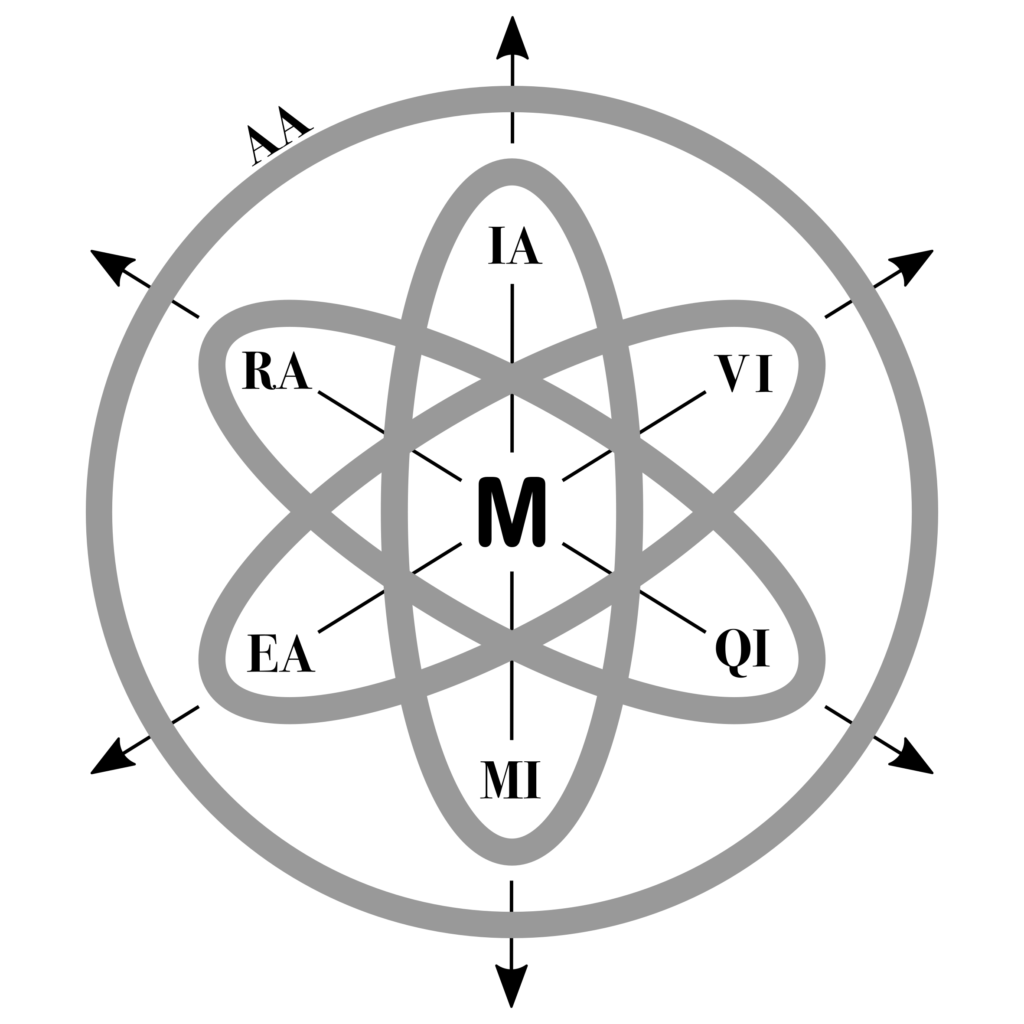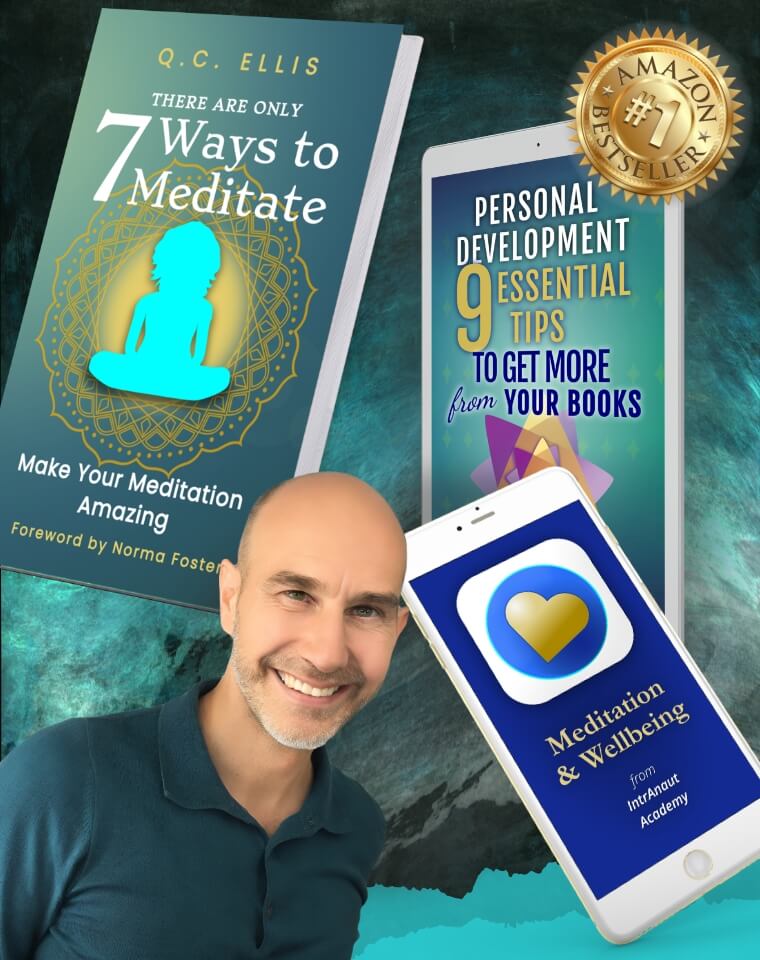From the book, There Are Only 7 Ways to Meditate : Make Your Meditation Amazing
Meditation
Meditation is a purposeful activity of mind, with seven principles and making use of the two core, or more, of the seven mind-technologies.
~ Meditation Teacher College
Meditation is limited to an activity of the mind. You’re not meditating if your activity includes anything other than the mind or less than the first two spheres of meditation (see also, Formal Practice and Informal Practice below):
Restful Absorption (RA)
Intentional Awareness (IA)
Engrossed Attention (EA)
Authentic Attitudes (AA)
Visualisation or Imagination (VI)
Question or Introspect (QI)
Mantra or Invocation (MI)

Seven Spheres, Mind-technologies, or Forms of Meditation
These terms relate to the seven mind-technologies of all meditations, as defined in PART TWO of the book, and briefly described below. Together, the seven make up the new framework for understanding meditation.
Restful Absorption (RA)
A core mind-technology within every meditation. Ideally, you are at rest, which means you are still and completely relaxed. You are relaxing enough for absorption to take effect.
Absorption – is what happens when you fall asleep, and can be mapped to the four brainwave frequencies (states) as described by science: Beta (normal awake state), Alpha, Theta, and Delta (fully asleep).
When your mind becomes calm, through RA, you can more effectively connect with your imagination, creativity, inner wisdom, and intuition. Absorption is the main ingredient in meditation that releases accumulated stress.
Cocoon Effect – is your meditation capsule – when absorption creates a comfortable space, in which you are undistracted. When RA is combined with EA, you can meditate for longer when cocooned in absorption.
Intentional Awareness (IA)
A core mind-technology within every meditation. Moment-by-moment conscious awareness. You are being aware on purpose. It can be called bare awareness, with nothing added, so you are not intentionally thinking about what you are aware of. Thoughts are allowed to be there, but ideally, you are not engaged in thinking. Sounds can be heard, but ideally, you are not actively listening. IA is a training that emphasises being present with whatever you are aware of. Because it is a training, we do not make the ideals into rules.
Engrossed Attention (EA)
EA steadies your IA (see above) in a narrow-focused attention. It uses introspection and memory to steady your focus on one object. EA has you know the details through a finer and finer degree of focus, creating more conscious awareness.
Engrossed – relates to the special relationship this technology has with absorption. It gets harder to draw yourself away from the object of your focus. It also helps you to relax deeply without falling asleep. The recommended object to train in EA is the breath.
Authentic Attitudes (AA)
Completely natural attitudes everyone possesses. They include curiosity, being gentle toward yourself, allowing, kindness, and others. You can strengthen an attitude as a meditation, or use them within all your meditations.
Neutral Zone – you are without positive or negative opinions.
Gentle – an energetic/supportive inner-environment where rest, or time-out, is available for you. Relax away from the negative thinking for a moment, and relax in a tender, forgiving, understanding, and soft manner.
Beginner’s Mind – is being curious about what may appear in your awareness. You’re open to the possibility of your assumptions being wrong, which means putting them to one side, while you treat your experience as an experiment. It takes courage to let go of the old and welcome the new.
Allowing – (acceptance) the present moment and everything in it, to be as it is. The present moment has already come into existence. Once you have noticed it, it is already in the past. Accept it already exists, and you cannot change it.
Appreciation – you look for something within your environment (external or internal) to appreciate. By that, I mean you can say “That’s OK.” It is a recognition and enjoyment of the good qualities of something, but that thing can be tiny. You are allowing yourself to experience beauty — no matter how small.
Kindness – to be kind toward yourself, to a certain extent, is simply to not judge yourself. Kindness arises spontaneously at this stage on the AA. Trust is an element of kindness.
See also, Distorted Attitudes, below.
Visualisation or Imagination (VI)
You are using your imagination. VI is especially broad in its uses. For instance, you can use VI for healing purposes or better performance (e.g., in sport). VI doesn’t have to be visual images in your mind.
Question or Introspect (QI)
You are contemplating, asking questions, or introspecting. Although this sounds like an analytical thought process, that part of the meditation is minimal. The emphasis is on the opening to intuition. We find this form of meditation within some types of prayer or insight/wisdom meditations.
Mantra or Invocation (MI)
Within the context of meditation, a mantra is a tone, or set of syllables, that have shown positive effects. A MI is used to invoke specific frequencies within your mind. The informal practice of MI is chanting. Depending upon your goals and preferences, there are many MI available.
Object of Meditation
The primary focus of your awareness. The object is what you are directing your attention toward, and attempting to notice something about it.
Formal Practice
Sitting, lying down, or standing still and completely focused (as best you can) on your meditation practice.
Informal Practice
When you are doing other things, you can partially use the mind-technologies. Informal practices either: (1) prepare you for meditation, or (2) help you gain extra time in training. Both are so the results of your formal practice will be greater. The mind-technologies you are using improve your other activities.
Distraction
The object of meditation is no longer within your awareness. You have forgotten your intention and are now involved with something else. It could be distracting thoughts, emotions, or physical discomfort. Your distraction could also be something pleasant or desirable. Either way, you are completely distracted away from your meditation. See Bubbles of Stress for the biggest reason for being distracted.
Bubbles of Stress
The reason why people have distracted minds is due to stress being released. The analogy used, is that a bubble of accumulated stress rises to the surface during meditation. When it hits the surface, the bubble bursts and releases the stress. The release (bursting of the bubble) disturbs our (energy, physical, emotional, mental) systems and this creates a distraction.
Wandering
You are not completely distracted. Your object is in the background and you’re still aware of it. Maybe you’re more interested in something else, or a part of your mind seems to be. Your mind has wandered, but not completely away from the object of your meditation.
Slumber
You become less conscious instead of more conscious during meditation. The cocoon effect of absorption is taking effect but you are drowsy – heading toward (unconscious) sleep.
Attitude
Our reaction – towards a thing, person, and oneself – is what we usually call an attitude. Defined as a learnt tendency to evaluate and react to things in a certain way.
Distorted Attitudes
A lifetime of accumulated stress causes the imbalance that creates distortions in your thinking, attitudes, and emotions. There are five main distorted (weather) patterns of attitude.
Whistling Wind of Cynicism – a scoffing, incredulous, cynical, sceptical mind. Pessimistic, pedantic, suspicious, distrusting, and jaundiced by life.
Foggy – a blank screen of confusion, leaving you feeling disoriented with an empty mind.
Weeping Cloud, feeling Emotional/Sensitive/Distressed/Anxious – feeling sad, upset, anxious or depressed, crying for no reason, and even the positive emotions feel too intense.
Stormy/Thunderstorm – maybe a minor storm of frustration, annoyance, irritability, impatience, or exasperation. Clouds of displeasure, dissatisfaction, simmering resentment, bitterness, or agitation may follow you. Or full-blown anger, outrage, wrath, or temper tantrum may strike.
Whirlwind/Typhoon/Cyclone/Tornado – a hyperactive mind, with a never-ending stream of thoughts, continually projecting into the future with strategising, evaluating, assessing, creating, narrating, rehearsing, imagining, or worrying, etc. Or ruminating on the past, by remembering, re-hashing dramas, establishing meaning, blaming, etc. You feel as if you cannot calm your mind.
IntrAnaut
A person who wants to explore the inner space of their mind so as to awaken to their true potential. There are various stages of training and mastery as an IntrAnaut. The difference between a normal meditator and an IntrAnaut, is the level of dedication to uncovering their True Nature. Knowing “Retreats create quantum jumps in your personal evolution”, an IntrAnaut will find ways to be on meditation retreat.
IntrAnaut™ is a trademark, owned by Colin Ellis and the Meditation Teacher College.
IntrAnaut Academy is a brand of the college and provider of the mobile app – IntrAnaut Meditation

About the Author
Colin (Q.C. Ellis) has been on meditation retreats in silence and solitude for longer than some monks. He has been studying meditation for over 23 years.
Known as a meditation maverick, he teaches methods to awaken your body’s natural restorative abilities and fire up your inbuilt happiness.
Keeping it real and grounded in personal experience, he is a Transformation Coach, Meditation Teacher, and founder of IntrAnaut™ Academy.
In person, Colin is approachable and would love to hear from you. For ways to connect, click HERE – ColinEllis.info
For additional resources, download his FREE mobile app – intrAnaut Meditation
More information on his book, There Are Only 7 Ways to Meditate: Make Your Meditation Amazing